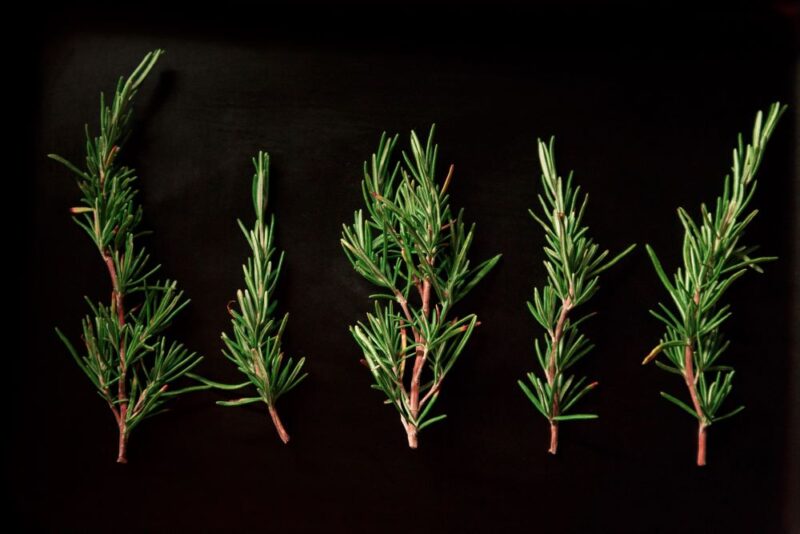Rosemary is an extremely common herb in witchcraft spaces. You will often see it recommended as a substitute for any herb, though I think that’s a stretch of its associations. I think that is attributed to Scott Cunningham in one of his books about herbs or witchcraft, though I can’t remember which. The information here, though short and sweet, comes directly from my own notes on Rosemary. I tend to work with Rosemary quite a bit. I have a small plant growing in my garden and I dry it myself when I need to add more to my herb storage. It’s a wonderful herb to have on hand and grow a working relationship with.
Description and Folklore
Rosemary is an evergreen shrub with fragrant needle-like leaves. It is native to the Mediterranean area and can have purple, pink, blue, or white flowers when it blooms. It can survive long periods of time without water and prefers well-drained soil. There are even special types of rosemary that can survive freezing temperatures down to -20C. It generally flowers in Spring and Summer but has been known to flower outside of its usual season, sometimes as late as December. When cultivated, Rosemary is used as a decorative plant in gardens or used fresh in cooking. Or for the witch, as a spell ingredient and plant ally. We can look to folklore and history to find some common associations with Rosemary, which I have outlined below, but the best way to understand Rosemary and its uses is to get to know it personally.
— Dioscorides, the writer of the famous De Materia Medica, wrote that “Rosmarinus is warming and cures jaundice. It is boiled in water and given to drink before exercises, and then he who exercises bathes and is drenched with wine. It is also mixed with remedies for the removal of fatigue, and in gleucinum ointments.” (1)
— Rosemary is one of several plants that is said to have aided the Virgin Mary in escape with baby Jesus after his birth. “The Palm, the Willow, and the Rosemary have severally been named as having afforded their shelter to the fugitives.” (2)
— It is said to aid in memory. “Rosemary, worn about the body, strengthens the memory.” (2)
— “In place of more costly incense, the ancients often employed Rosemary in their religious ceremonies, and especially at funeral rites. The Romans ornamented their Lares, or household gods, with this plant, and at the Palilia, or festival held in honour of Pales, the purification of the flocks was made with the smoke of Rosemary.” (2)
— “It is a common saying in Sicily, that Rosemary is the favourite plant of the fairies, and that the young fairies, under the guise of snakes, lie concealed under its branches.” (2)
How to Grow Rosemary
Rosemary is best planted in the Spring after the last frost if starting outdoors. If starting indoors, Rosemary can be started any time. It prefers full sunlight and well-drained neutral-acidic soil. It is fairly heat-tolerant and can go a while without water once it’s mature. If planting outdoors, make sure that no tall plants or trees will block the sun. Let the soil dry completely before watering again. Rosemary prefers a humid climate but too much humidity and heat can cause the plant to rot and die. Rosemary is also a self-pollinator and will attract bees and other pollinators to your garden. However, Rosemary will not flower for at least one season.
To store Rosemary for use, clip the stem and hang it in a cool, dry place to let it dry out. Then remove the leaves from the stem and store in an airtight container.
Magical Uses
- Ward off evil
- Protection
- Purification
- Memory Enhancement
Possible Medicinal Uses*
- Strengthening the hair and scalp
- Reduce dandruff and stimulate hair growth
- Increase circulation
- Reduce inflammation of the skin and joints
* This is listed as possible because, while studies have been done on the use of Rosemary in treating certain conditions, more evidence and study needs to be done. This medical information comes from two studies, both listed below as 3 and 4.
(1) Dioscorides Materia Medica – Internet Archive
(2) Plant Lore, Legends, and Lyrics, by Richard Folkard
(3) Therapeutic effects of rosemary… National Library of Medicine
(4) Promotion of hair growth by Rosmarinus officinalis leaf extract… PubMed
Note on UPG: Plant correspondences can be subjective based on folklore and experience. Please use this post as a foundation for your further work with the plant.
Don’t forget to follow me on social media and subscribe to my newsletter.
Facebook| Instagram| Pinterest | YouTube | Newsletter



Leave a Reply